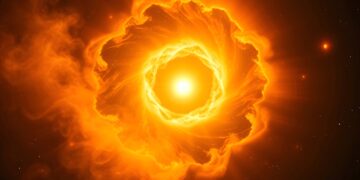For decades, astronomers have been captivated by yellow hypergiants, a rare and enigmatic class of massive stars known for their dramatic and unpredictable outbursts. Among them, Rho Cassiopeiae (Rho Cas) has emerged as one of the most well-studied examples, offering a unique window into the life cycle of these colossal stars. A recent five-year study, combining over 138 years of historical data, has provided groundbreaking insights into the nature of Rho Cas and its kin, revealing a pattern of cyclical eruptions and rapid evolutionary changes.
What Are Yellow Hypergiants?
Yellow hypergiants are among the most luminous and massive stars in the universe. They exist in a highly unstable phase, experiencing extreme temperature fluctuations and episodic eruptions that eject massive amounts of material into space. Unlike ordinary stars, their surfaces can expand to 400 to 700 times the Sun’s diameter, and they shine with a luminosity up to 500,000 times greater than our Sun .
These stars reside in a critical transitional phase between red supergiants and luminous blue variables (LBVs), meaning they are either on the brink of a supernova explosion or evolving into hotter, more compact stars.
Patterns of Recurring Eruptions
A five-year-long international study, conducted by researchers from Leiden University (Netherlands), the Royal Observatory of Belgium (ROB), and Durham University (UK), has provided groundbreaking insights into the violent outbursts of Rho Cas. By analyzing observational data spanning 138 years (1885-2023), scientists uncovered a pattern of cyclical eruptions occurring every 10 to 40 years.
These outbursts are accompanied by surface temperature fluctuations, ranging from 4,500°C to 7,500°C. During these episodes, large amounts of stellar material are ejected, forming immense gas shells around the star.
Why Do Yellow Hypergiants Experience These Outbursts?
At the heart of these eruptions are intense stellar pulsations. The study found that as Rho Cas approaches an outburst, its pulsation periods lengthen, and their amplitude increases. This signals that strong radial pulsations are a key trigger for these massive eruptions.
These pulsations likely result from:
- Internal instability: The star’s core produces immense radiation pressure that struggles to be contained.
- Opacities in the outer layers: Variations in the star’s atmosphere cause light to be trapped and released in dramatic bursts.
- Mass loss events: Over time, the star sheds huge amounts of material, forming expanding shells of gas and dust.
Could Yellow Hypergiants Be the Predecessors of Supernovae?
The fast evolution of yellow hypergiants suggests that they are nearing the end of their stellar lifetimes. There are two possible fates for Rho Cas and similar stars:
- They explode as core-collapse supernovae: If the star retains enough mass, its core will eventually collapse under its own gravity, resulting in a Type II supernova explosion.
- They transition into Luminous Blue Variables (LBVs): Some yellow hypergiants may survive their instability by shedding even more material, eventually evolving into LBVs before going supernova.
These findings are essential for refining astrophysical models and improving our ability to predict when and how massive stars will explode.
A Collaborative Effort in Astrophysics
One of the most exciting aspects of this study is the contribution of amateur astronomers worldwide. Data from amateur observatories helped fill observational gaps, allowing scientists to track brightness variations in Rho Cas over more than a century.
According to Dr. Alex Lobel (Royal Observatory of Belgium), “This study is the first time we’ve been able to combine nearly all available historical data on Rho Cas, thanks to valuable contributions from both professional and amateur astronomers”.
Key Takeaways from the Study
This research has transformed our understanding of yellow hypergiants by:
- Confirming that pulsations drive massive stellar eruptions.
- Identifying cyclical outbursts that repeat every 10 to 40 years.
- Refining models of stellar evolution leading to supernova explosions.
- Demonstrating the critical role of historical data in modern astrophysics.
By unraveling the mystery of Rho Cas’s outbursts, astronomers are better equipped to predict the behavior of other massive stars nearing the end of their lifecycles.
New Observations with Next-Generation Telescopes
Scientists are now turning to next-generation observatories, such as the James Webb Space Telescope (JWST) and the Extremely Large Telescope (ELT), to further investigate hypergiant behavior. Future research aims to:
- Monitor Rho Cas’s pulsation cycles in even greater detail.
- Study other yellow hypergiants to confirm if they follow similar evolutionary paths.
- Develop more precise models for predicting stellar outbursts and supernovae.
These advancements will help bridge the gap between stellar physics and supernova studies, providing deeper insights into the most extreme objects in our universe.
Conclusion: A Rare Glimpse Into the Life of a Dying Giant
The recent study of Rho Cassiopeiae and its hypergiant kin marks a significant milestone in astrophysics. By analyzing decades of data, astronomers have unveiled the mechanisms behind their violent outbursts, shedding light on their rapid and unstable evolution.
Reference:
A. M. van Genderen et al, Investigation of the pulsations, outbursts, and evolution of the yellow hypergiants, Astronomy & Astrophysics (2025). DOI: 10.1051/0004-6361/202449384



















